Some people can’t handle their spice. But if you’re the kind of person who wants your food to make you cry, thank native cultures in the Americas for being the first to cultivate peppers.
For years, people have debated which is the hottest pepper in the world, with bitter rivalries developing between countries who swore their strain of the plant was hotter and, therefore, better. Enter the Scoville scale, made by Wilbur Scoville in 1912 to settle the question once and for all. The scale measures the amount of capsaicin, the component responsible for delicious heat.
Ready to spice up your life? These are the 15 hottest peppers in the world — and recipes you can use them in.
15. New Mexico Scorpion
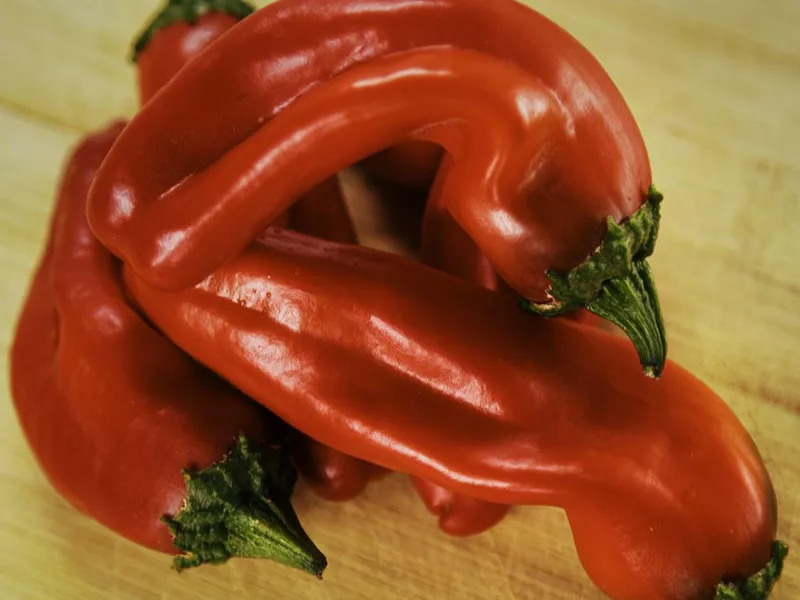
desertsolitaire / Getty Images
Scoville heat units: 500,000 – 1,191,595
Developed in 2013 by a New Mexico team, this strain of scorpion pepper is rated as “really hot” on the Scoville scale. By comparison, habanero red pepper’s Scoville heat units (SHU) is 150,000 to 350,000 — not even close to the New Mexico scorpion!
*Scoville heat units come from scovillescale.org.
What to Cook With New Mexico Scorpion Pepper
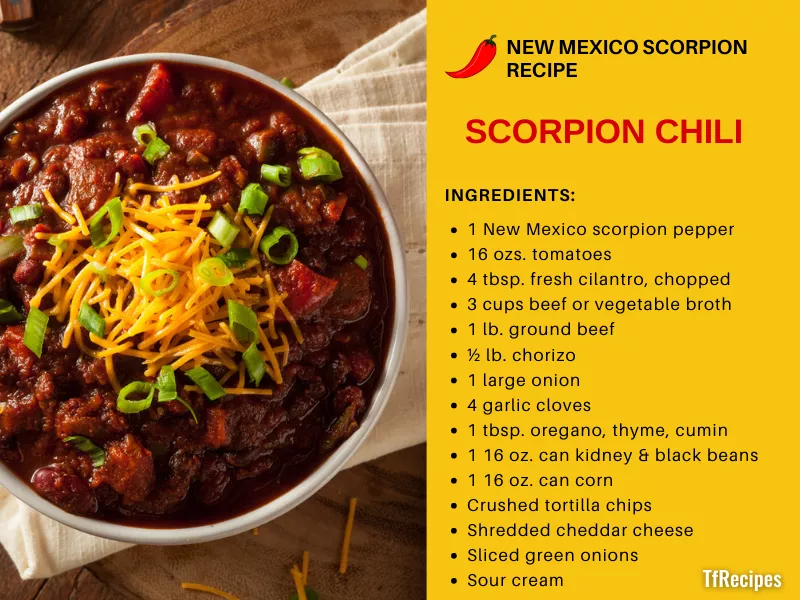
Getty Images
- In a medium saucepan combine the New Mexico scorpion pepper with tomatoes, garlic, fresh cilantro and 1 cup broth over high heat.
- Bring to a boil, then lower heat and simmer for 10 minutes.
- Pour this mixture into a blender and puree. Set aside.
- In a large pot over med heat, brown the chorizo and beef.
- Add onions and cook until well browned.
- Add remaining spices. Continue to cook for 5 minutes, stirring occasionally.
- Add beans, remaining broth and pureed mixture. Simmer on low heat for one hour. Add salt and corn.
- Garnish with green onions, tortilla chips, cheese and sour cream.
Recipe by FtRecipes with some changes.
14. Yellow Brain Strain
Scoville heat units: 700,000 – 1,200,000
The yellow brain strain is a type of 7-pot pepper (of which you’ll see a lot on this list) that gets its name from its unusual appearance. It’s round, short and lumpy — though to be very honest, it doesn’t look like a brain. We’re sure whoever came up with the name was struggling to think of words after trying this absurdly strong pepper.
What to Cook With Yellow Brain Strain Pepper

Getty Images
- Heat a saucepan over medium heat. Add the onion and olive oil, and cook for about 5 minutes.
- Add the white wine, and simmer to reduce, about 1 to 2 minutes.
- Add the tomatoes, yellow brain strain peppers, garlic, 1/4 cup basil and salt to taste. Stir.
- Cook until the tomatoes break down. Reduce heat to low, and simmer for about 15 minutes.
- Preheat oven to 350 degrees Fahrenheit.
- In a mixing bowl, combine the flour, baking soda, salt, butter and water. Mix to form the dough. Knead for about 5 minutes.
- Separate the dough into two portions, and flatten each with a rolling pin to about 1/4-inch thickness.
- Heat a large grilling pan to medium-high heat and cook each flatbread dough for about 2 to 3 minutes, or until the dough hardens. Flip and cook another 2 to 3 minutes. The dough will form a cracker-like crust.
- Top each pizza crust with the tomato-yellow brain strain sauce. Top with cheese and the remaining basil. (Optional: Add roasted jalapeños.)
- Bake for about 10 minutes, or until the cheeses are nice and melted.
Recipe from Burn Blog with some changes.
13. Brain Strain
Scoville heat units: 800,000 – 1,200,000
The original brain strain is fiery red, which can come off as a helpful warning. You’ll need to have some serious spice resistance to handle this pepper. You can thank (or blame) a North Carolina grower named David Capiello for making brain strain in 2010.
What to Cook With Brain Strain Pepper

Getty Images
- Make the marinade by whisking all of the ingredients (except for the steak) in a medium-sized bowl until well combined.
- Add marinade to a large sealable gallon-sized bag with the steak, and rub it thoroughly into the meat.
- Seal and refrigerate for at least 2 hours, or overnight.
- Remove steak from bag and dispose of marinade.
- Fire up your grill to medium-high heat.
- Grill the marinated steak for 8-10 minutes per side, or until cooked to your liking.
Recipe from Chili Pepper Madness with some changes.
12. 7-Pot Jonah Pepper
Scoville heat units: 800,000 – 1,200,000
Another 7-pot strain, the 7-pot Jonah tried to one-up its siblings by growing larger and being a bit rounder. The pepper can get up to the size of a golfball, which makes it a favorite with home chefs that want to add heat to all their recipes. Hey, we love a pepper that’s efficient.
What to Cook With 7-Pot Jonah
- In a large bowl, place the chicken (cut into 2-inch pieces), green seasoning, garlic, soy sauce and ketchup, along with salt and pepper to taste.
- Toss to mix and coat the chicken with the seasonings. Set aside and let marinate for at least 1 hour.
- Pour the oil into a large pot and place over medium-high heat. Let it heat until hot but not smoking.
- Make the burnt sugar by sprinkling the cane sugar into the hot oil in an even layer. Let the sugar melt until it starts to froth and bubble.
- As soon as the edges of the froth/bubbles start to turn a slight shade darker, immediately add the seasoned chicken. Stir to mix and coat with the burnt sugar. Cook for 7-10 minutes.
- Add the onion, pigeon peas and carrots (optional), and cook for 1 minute.
- Pour in the coconut milk and the chicken stock or water. Season with salt, and pepper to taste.
- Toss in the whole 7-pot Jonah pepper. Bring the mixture to a boil, and cover the pot. Once it boils, partially remove the lid and cook for 7-8 minutes.
- Cover the pot fully, reduce the heat to low, and let cook for 25 to 30 minutes or until all the liquid has been absorbed.
- Sprinkle the green onions on top, and fold into the pelau. Taste and adjust seasonings with salt and pepper if necessary.
Recipe from The Spruce Eats with changes.
11. 7-Pot Barrackpore
Scoville heat units: 900,000 – 1,300,000
The 7-pot peppers have a serious sibling rivalry happening, and the 7-pot Barrackpore is amongst the top five hottest. Originating in Chaguanas, Trinidad, this is the first strain on the list to be a 10++, which the Scoville scale translates to “fiery pot.”
Fair warning: People from Trinidad and Tobago do not mess around when it comes to spice.
What to Cook With 7-Pot Barrackpore Pepper
- To make the roti, in a large bowl place the flour, salt and baking powder and mix. Start adding some water and kneading. Add more water as necessary to form a smooth dough.
- Cover the dough with a tea towel or plastic wrap, and let it rest for 15 minutes. Divide into two dough balls, dust your work surface with flour, and with a rolling pin, roll out to a circle.
- In a small bowl, place the butter and oil and mix well. Roll out one of the dough balls flat and cut from the center. Brush some of the oil/butter mix over the surface and roll to form a cone. Tuck in both ends to seal, cover with plastic wrap, and let rest for 10 minutes.
- Place the pepper, carrots, potato and cheese in a bowl, and mix it evenly.
- On a flour-dusted surface, roll out one of the dough balls the size of your tawa, or baking stone. Over a low flame, brush some of the oil/butter mixture onto the tawa, then place the rolled-out dough onto it.
- Top with the filling evenly, leaving about 1/4 inch off the side.
- Roll out the other dough ball in the same shape and size as the previous one; then gently place it on top of the one on the tawa. Using a fork, press down on the edges to help seal the roti.
- Brush some of the oil/butter mixture on the top layer, then flip. Turn the heat up.
- Cook 3-4 minutes, brush more mix on top, and flip back.
- Leave for 1-2 minutes, and remove from heat.
Recipe from Caribbean Pot with some changes.
10. 7-Pot Lucy
Scoville heat units: 900,000 – 1,359,284
Coming in as the 10th hottest pepper in the world is the 7-pot Lucy, which was made by crossing the 7-pot Jonah with the Naga Viper, which we’ll see shortly. A bite of this will probably make your mouth hurt for days, but its fruity flavor provides a contrast that people just can’t seem to resist.
What to Cook With 7-Pot Lucy Pepper
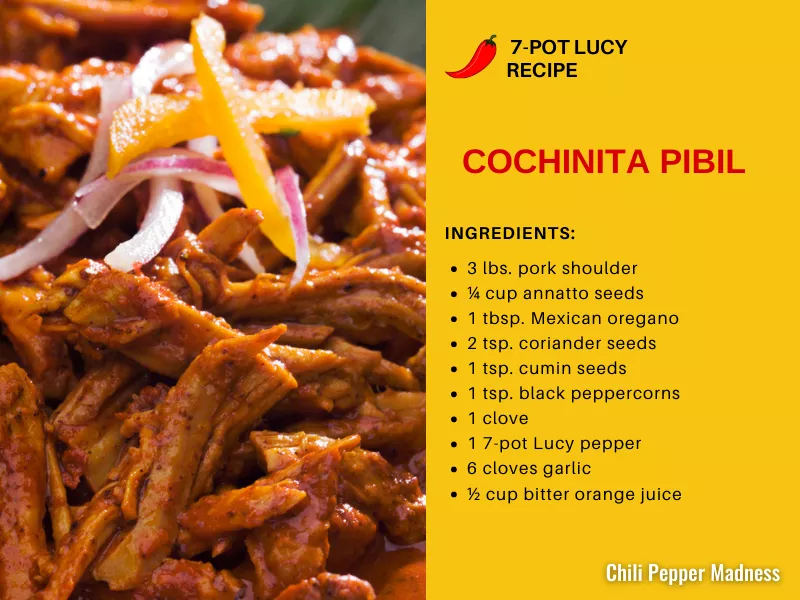
Getty Images
- To make the achiote paste, add the annatto seeds (achiote), oregano, coriander, cumin, peppercorns and salt to a food processor or blender. Add the garlic, orange juice and vinegar. Process to form a thick paste.
- Bring the pork shoulder to room temperature. Slice it into 2-inch cubes, and set into a bowl.
- Rub the sliced pork down thoroughly with the achiote paste. Pour in the remaining orange juice to cover the pork. Cover the bowl and refrigerate. Marinate for at least 4 hours, or overnight.
- Add the marinated pork along with the marinade to a large pot. Add 1/2 cup water and cover. Heat to medium-low and simmer for 4 hours, or until the meat can be easily shredded with a fork.
- Shred the cooked pork, and serve on warmed tortillas with your choice of toppings.
Recipe from Chili Pepper Madness with some changes.
9. Naga Viper
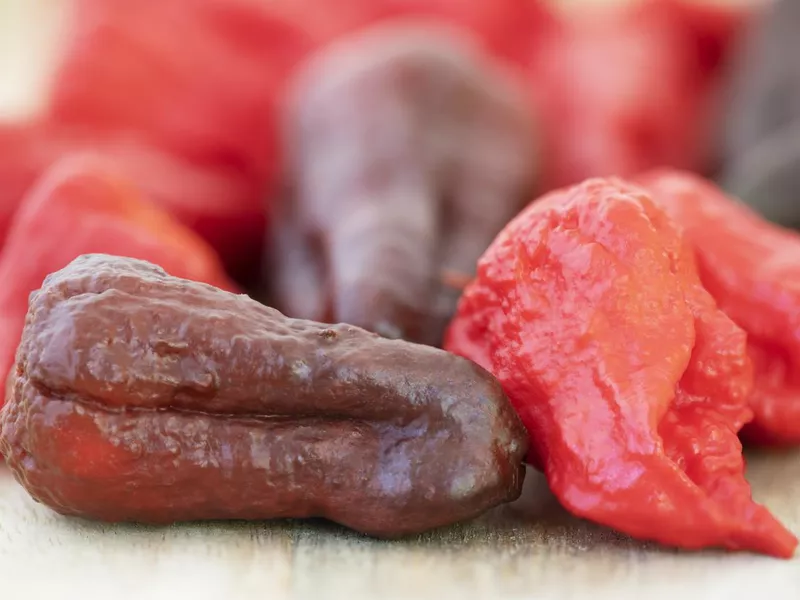
cheche22 / Getty Images
Scoville heat units: 600,000 – 1,382,118
Back in 2011, the naga viper broke the Guinness World Record for being the world’s hottest chili. Since then, it has been surpassed by other peppers, but it continues to be too hot for most mortal humans to handle.
What to Cook With Naga Viper Pepper
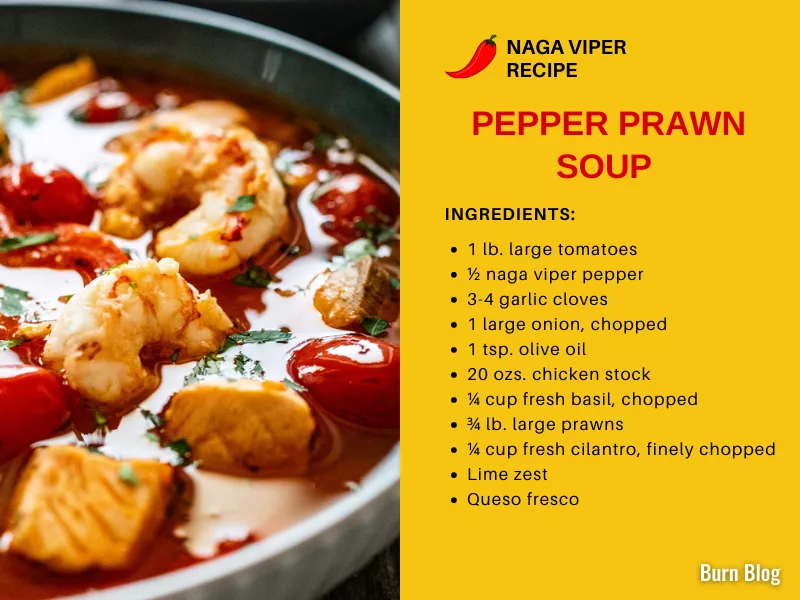
Getty Images
- Set your oven to broil.
- Slice tomatoes in half lengthwise, and place them on large baking sheets that have been lightly oiled.
- Wrap garlic cloves in aluminum foil.
- Broil the tomatoes and naga viper peppers for 10 minutes, or until they are charred and skins are loose. Remove and cool slightly. Note: Naga vipers are extremely hot, start with a small amount and add as needed to fit your spice resistance level.
- Broil the King Nagas along with the tomatoes for 10 minutes or until the skins are charred, and remove from the oven to cool.
- Bake the garlic in the bottom of the oven for 20 minutes. Remove from heat, peel and chop.
- Remove skins from the tomatoes, and add to a food processor until smooth.
- Heat a large pan to medium, and add the onion with olive oil. Cook for about 5 minutes, or until the onion softens.
- Add the pureed tomatoes to the pan and stir. Add garlic and cook for about 10 minutes.
- Add the chicken stock and cover. Reduce heat and simmer for about 15-20 minutes.
- Add the prawns and cook for about 2-3 minutes, or until the prawns are cooked through.
- Serve the finished soup in bowls, and top with lime zest, cilantro and crumbled queso fresco.
Recipe from Burn Blog with slight changes.
8. Trinidad Red Scorpion
Scoville heat units: 500,000 – 1,390,000
The Trinidad red scorpion pepper is the original scorpion pepper that comes, of course, from Trinidad and Tobago. Named for its scorpion-like tail, we assure you that this pepper will most definitely sting you with absolutely no mercy.
At this point, all upcoming peppers are used mostly as spices and in very small amounts.
What to Cook With Trinidad Red Scorpion Pepper

Getty Images
- Lightly oil the bottom of a soup pot. Add minced garlic and curry paste, and stir until aromatic.
- Add broth and chopped sweet potato.
- Cover on low to medium heat until potato is soft, about 8-10 minutes.
- In a separate pot, boil water and cook pasta for 3 minutes or so; then drain and set aside.
- Once the potato is tender, add the coconut milk and brown sugar.
- Stir and taste, and adjust flavoring to your liking.
- Turn the heat on low, and add the noodles and stir.
- Top with red onion, lime, peanuts, cilantro and Trinidad red scorpion flakes.
Recipe from Sonoran Spice Company with slight changes.
7. Komodo Dragon
Scoville heat units: 500,000 – 1,400,000
People who say British food is bland have obviously never heard of Komodo dragon pepper. Made in the U.K., the long and soft pepper is dangerous like the animal it’s named after. At first, it’s fruity and delicious, and then it attacks with the force that we imagine is as painful as the venomous bite of a Komodo dragon. Consume with caution.
What to Cook With Komodo Dragon Pepper
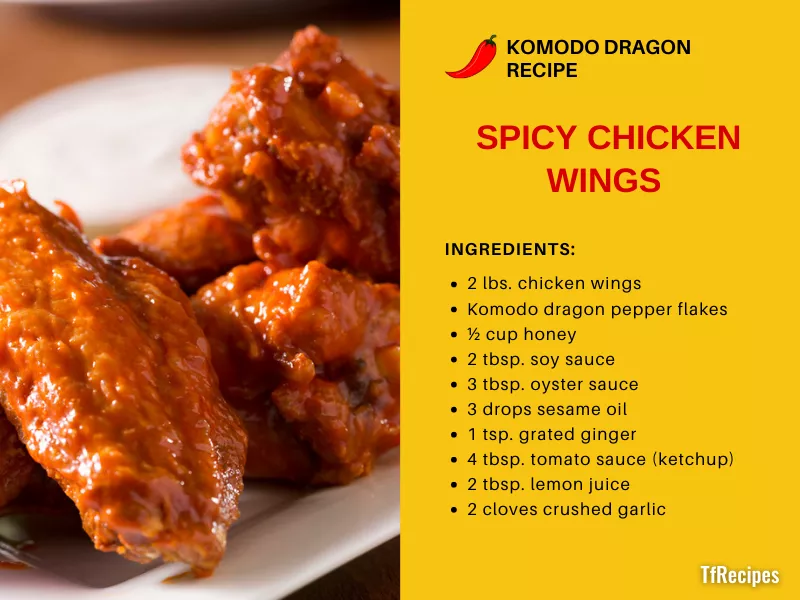
Getty Images
- Cut tips off the chicken wings and discard.
- In a large bowl. mix together all the ingredients until smooth. Gradually add the Komodo dragon pepper to taste.
- Add wings to the marinade, and place in the fridge for about 20 minutes.
- Cook on a BBQ or place in a moderate oven, about 180 degrees until caramelized and golden.
Recipe from TfRecipes with slight changes.
6. Butch T
Scoville heat units: 800,000 – 1,463,700
The Butch T is a strain of the Trinidad scorpion pepper that dethroned the naga viper as the hottest pepper in 2011, the very same year the latter had earned the title. (Sorry naga!)
It was named after pepper and hot sauce maker Butch Taylor, who played a role in spreading the original scorpion pepper seeds in the U.S. The flavor is so strong that only masochists consume it raw. Most people add a very conservative amount to cooked foods like soup.
What to Cook With Butch T Pepper
- Chop the onions, pepper, garlic and chadon beni.
- Add the caralai and carrot.
- Add lime juice and salt.
- Mix thoroughly and serve.
Recipe from Simply Trini Cooking with slight changes.
5. 7-Pot Primo
Scoville heat units: 1,100,000 – 1,469,000
The competition is heating up as we get into the top five hottest peppers in the world. In 2005, a Louisiana native Troy Primeaux crossed the naga morich and the Trinidad 7-pot to make the 7-pot Primo (which he named after himself). As he writes on his LinkedIn page: “One 7-pot primo pepper is 300 times hotter than a jalapeño!”
That really puts things into perspective.
What to Cook With 7-Pot Primo
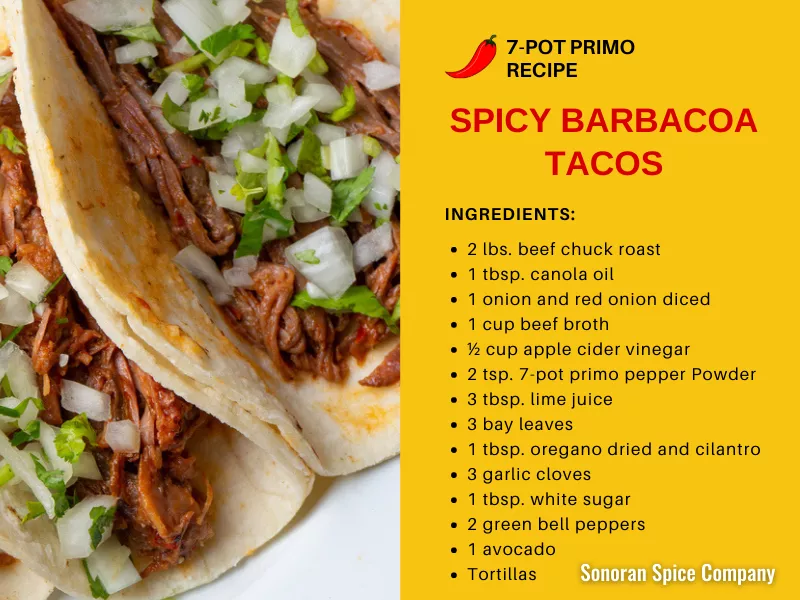
Getty Images
- Start by browning all of the sides of the beef pieces in a big nonstick pot. Set aside.
- Add the canola oil and saute the onion until tender, then add the garlic and the 7-pot primo powder.
- Saute the pepper with garlic and onion for 4 minutes.
- Pour the beef broth, lime juice, apple cider vinegar and bay leaves. Add salt and pepper.
- Bring to a boil, add the meat pieces and reduce the heat. Cover and let it cook for 2 to 3 hours. Mix occasionally, making sure there is enough liquid at all times.
- When the meat is tender, remove the pieces and shred them with two forks. Put the pieces back in the pot and mix, thoroughly soaking the meat in the sauce.
- Add to tortillas and top with sliced green bell peppers, red onion and avocado.
Recipe is from Sonoran Spice Company with slight changes.
4. 7-Pot Katie
Scoville heat units: 1,200,000 – 1,590,000
The 7-pot Katie is the first pepper to reach a SHU over 1.5 million, earning the rating of 10+++, or extreme hot. Believe it or not, the Katie is not even the spiciest of the 7-pot peppers, though it is the hottest strain made in the U.K.
Besides being a source of pride for British people, the Katie brings literal tears to the eyes of those who try it. Whether that’s a good thing or not depends on how much pain you’re willing to put up with in the name of spice.
What to Cook With 7-Pot Katie Pepper
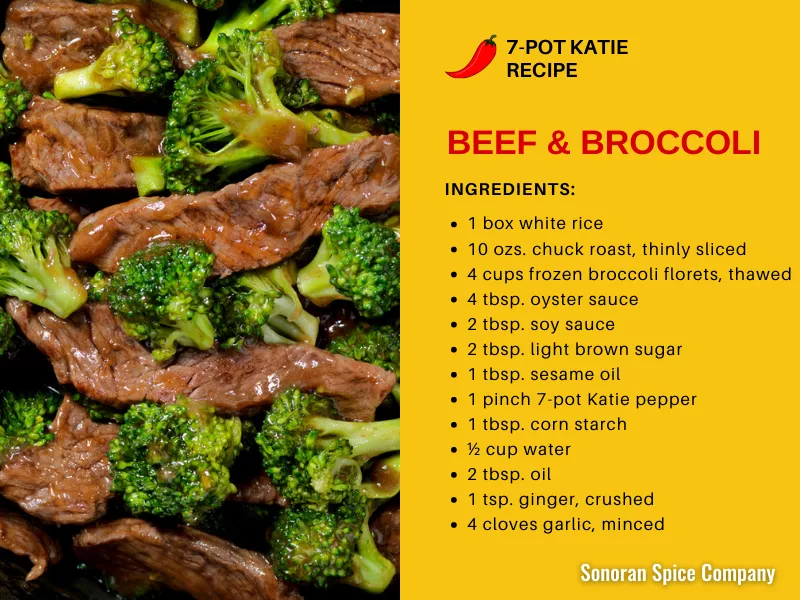
Getty Images
- In a medium mixing bowl, combine oyster sauce, soy sauce, light brown sugar, sesame oil, 7-pot Katie pepper powder, water and corn starch.
- Stir the mixture together until lump-free and well combined.
- Heat 2 teaspoons of oil in a frying pan. Add garlic and ginger to saute for about a minute, or until the garlic is fragrant.
- Add in thin slices of beef and cook until browned, for about 3-4 minutes.
- Pour the sauce mixture into the saucepan and add broccoli. Toss to coat and reduce the heat to low. Cook for an additional 3-4 minutes.
- Serve over warm rice.
Recipe is from Sonoran Spice Company with slight changes.
3. 7-Pot Douglah
Scoville heat units: 1,000,000 – 1,853,936
This is it, this is the one! The 7-pot Douglah beats out all its siblings as the hottest pepper of the strain. Now would be a great time to explain that these peppers got their name because, in Trinidad, it’s said they’re spicy enough to heat up seven pots.
The strain is also known as the chocolate 7-pot because of its rare brown color. Despite earning the bronze medal for heat, the Douglah isn’t the strongest pepper from Trinidad. That honor goes to the second-hottest pepper in the world.
What to Cook With 7-Pot Douglah Pepper
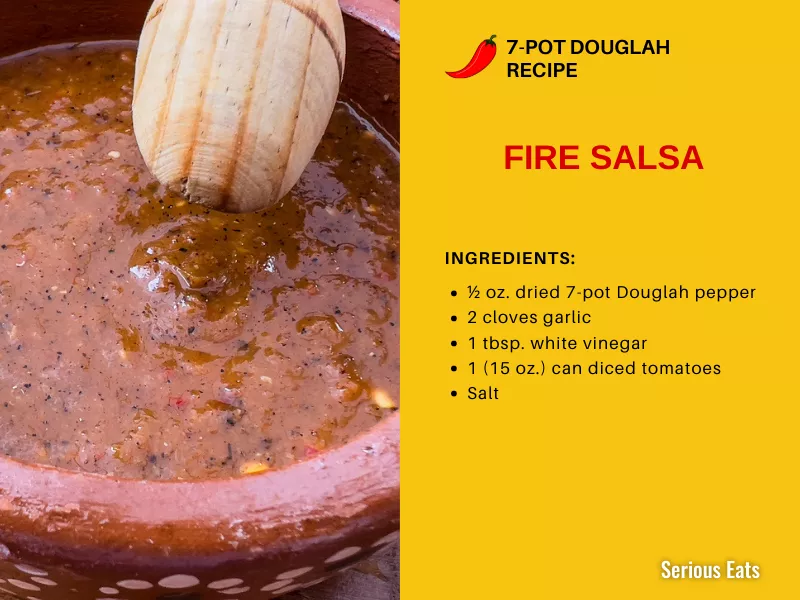
Getty Images
- In a bowl, add dried peppers, and cover with hot water.
- Rehydrate for 15 minutes.
- In a blender, combine peppers and 1/3 cup soaking water.
- Add garlic and vinegar and puree.
- In a bowl, add pepper puree to tomatoes, and combine.
- Let sit for a couple of hours.
Recipe from Serious Eats with slight changes.
2. Trinidad Moruga Scorpion
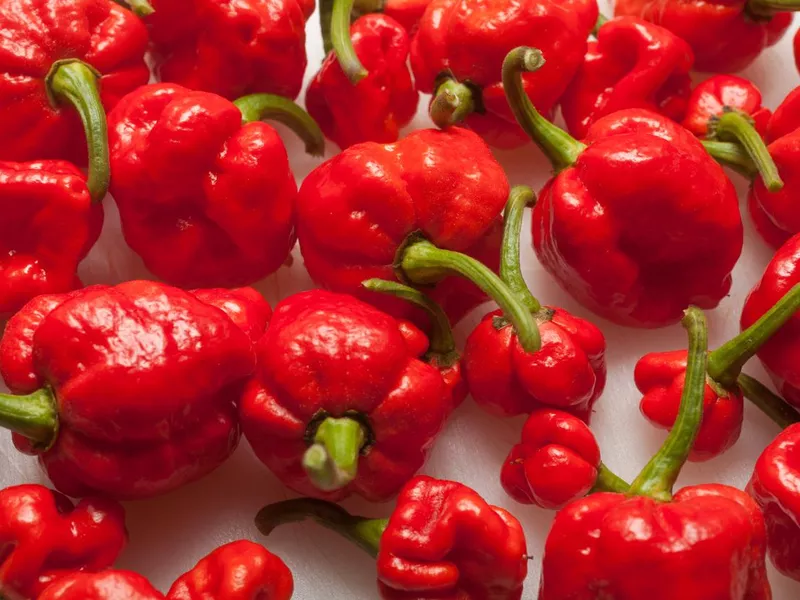
blackboard1965 / Getty Images
Scoville heat units: 1,500,000 – 2,009,231
The first pepper to reach more than 2 million SHUs, the Trinidad Moruga scorpion packs many punches, dealing blow after blow with increasing intensity, until you feel like you might actually pass out. If you’re not from Trinidad and Tobago, you may want to think twice about putting your mental and physical health at risk. No, seriously, even cooking with it can cause skin burns, which is why people have to wear gloves to handle this pepper.
On the other hand, if you like a challenge, overcoming even a bit of the Moruga scorpion probably feels akin to winning an Olympic medal or climbing one of the seven summits. If you live to tell the tale, you’ll definitely win the admiration of the world — or at least the pepper world.
What to Cook With Trinidad Moruga Scorpion Pepper

Getty Images
- Wearing disposable gloves and being careful not to get any in your eyes or on your skin, roughly chop the Trinidad Moruga pepper. (Be careful with the level of spice, use less pepper if necessary).
- Place the pepper, mango, onion, green onions and garlic into a blender. Pour in the vinegar, lime juice and vegetable oil.
- Blend until the mixture is very finely chopped.
- Add dry mustard powder, salt, curry powder and lime zest.
- Blend again until the sauce is smooth.
- Pour into clean jars, and store in the refrigerator.
Recipe from TfRecipes with slight changes.
1. Carolina Reaper
Scoville heat units: 1,500,000 – 2,200,000
If the Carolina Reaper had existed in the 14th century, we’re sure Dante would’ve included it in the description of his Inferno. Reaching up to 2.2 million SHU, the pepper lives up to its name by getting you closer to a meeting with the Grim Reaper.
Is it worth trying? Absolutely! Brave souls who have volunteered as tributes report it to have a pleasant fruity flavor that’s almost cherry-like. Not that that tones down any of the heat, which is so extreme that the Carolina Reaper has sat on the throne as the hottest pepper in the world since 2013.
Side effects of eating even a hint of this pepper may include hysterical laughter, uncontrollable coughing, hallucinations, the urge to confess all your sins in a bid for forgiveness and extreme dehydration after spending entire days in the bathroom. OK, this is not an official list made by doctors, but just trust us.
What to Cook With Carolina Reaper Pepper
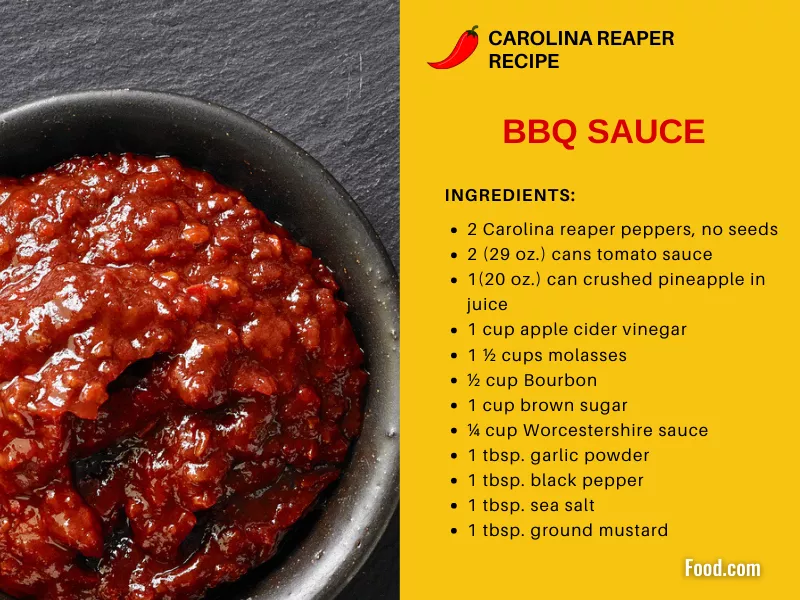
Getty Images
- Puree peppers and pineapple with juice in a blender until smooth.
- Combine all ingredients in a medium-sized stockpot.
- Bring to a boil, reduce heat to low and simmer for 1.5 to 2 hours stirring occasionally.
- Once the sauce has reached your desired thickness, transfer to 1-pint or 1/2-pint jars, leaving 1/2-inch headspace.
- Secure lids and bands, and process for 20 minutes in a boiling water canning bath.
- Remove from canner, and allow to cool overnight.
- Transfer any jars that do not seal to the refrigerator.
- Sealed jars can be stored for up to a year in a cool dry area.
Recipe is from Food.com with slight edits.